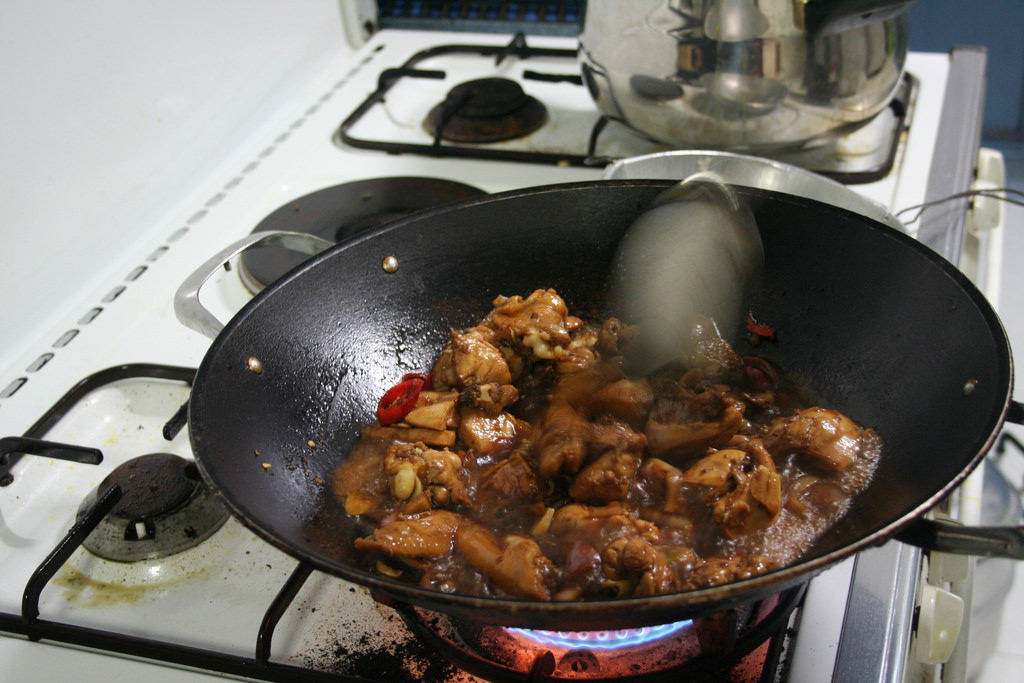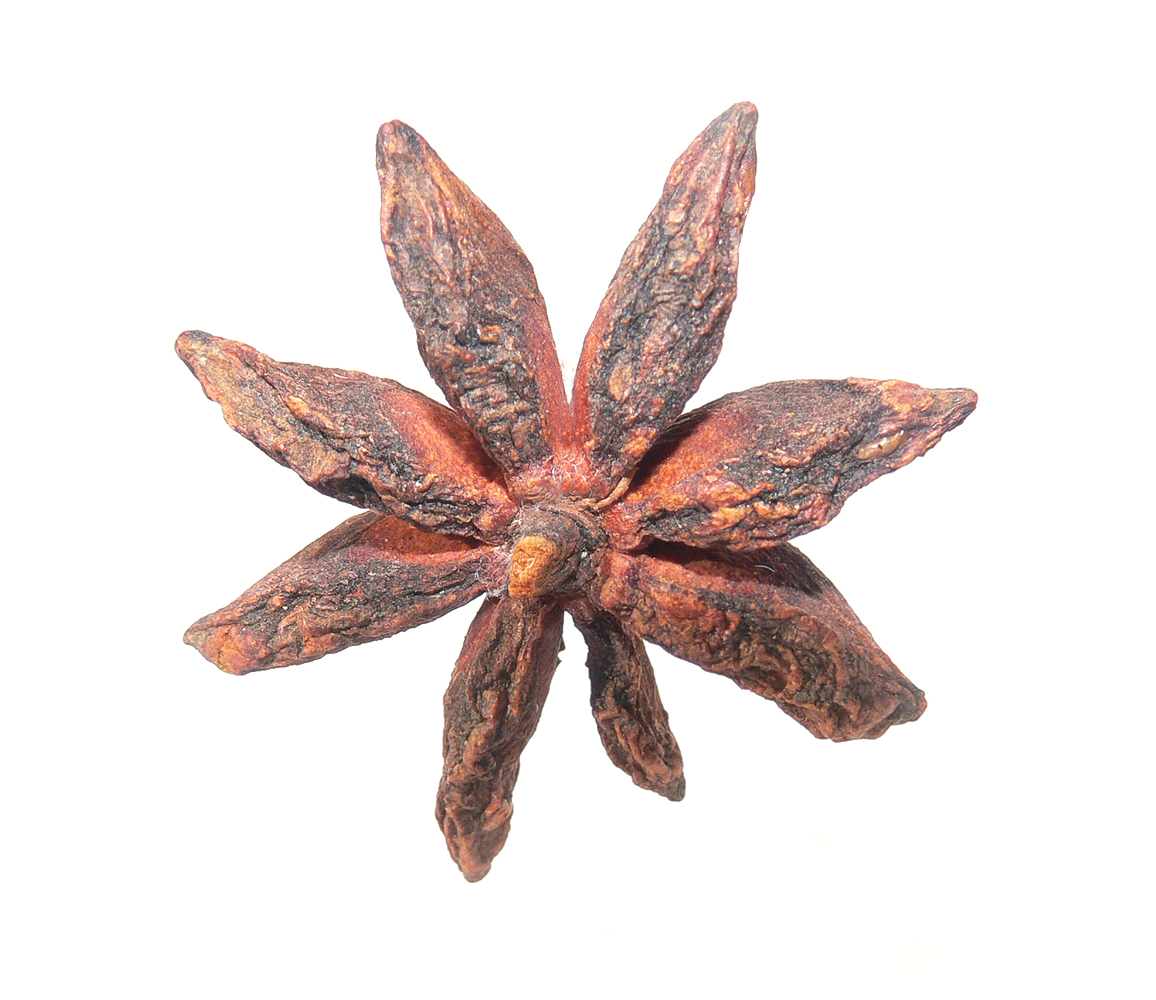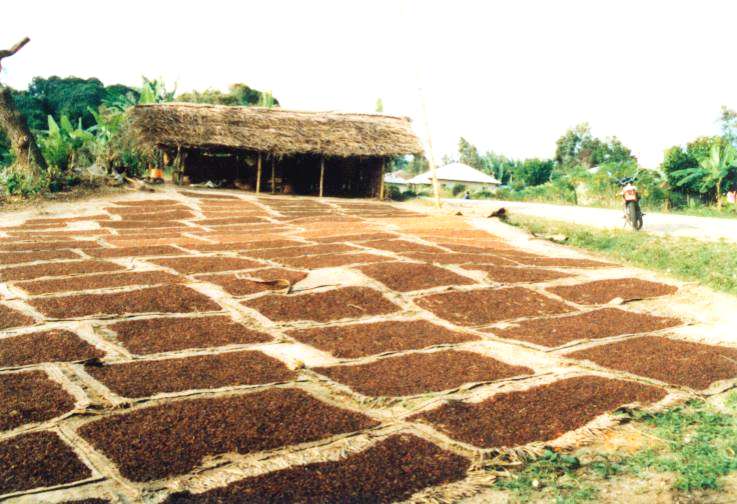|
Ayam Kecap
Ayam kecap or ayam masak kicap is an Indonesian Javanese chicken dish poached or simmered in sweet soy sauce (''kecap manis'') commonly found in Indonesia, Malaysia and Singapore. History and origin Fried chicken in sweet soy sauce is a typical chicken dish commonly served across Indonesia. However, it is more precisely of Javanese-Chinese origin. The recipe follows the production of Indonesian ''kecap manis'' (sweet soy sauce). Historically, soy sauce production is linked to Chinese influence in the archipelago. However, Indonesian Javanese version of soy sauce has its own twist, which is a generous addition of thick liquid palm sugar (''gula jawa'') with consistency of molasses. The ''ayam kecap pedas'' is spicier version which also adds a generous amount of chili pepper. Regional variations Indonesia In Indonesia, ''ayam kecap'' is pieces of chicken simmered in ''kecap manis'' (sweet soy sauce), spiced with shallot or onion, garlic, ginger, pepper, leek and tomato. Othe ... [...More Info...] [...Related Items...] OR: [Wikipedia] [Google] [Baidu] |
Indonesia
Indonesia, officially the Republic of Indonesia, is a country in Southeast Asia and Oceania between the Indian and Pacific oceans. It consists of over 17,000 islands, including Sumatra, Java, Sulawesi, and parts of Borneo and New Guinea. Indonesia is the world's largest archipelagic state and the 14th-largest country by area, at . With over 275 million people, Indonesia is the world's fourth-most populous country and the most populous Muslim-majority country. Java, the world's most populous island, is home to more than half of the country's population. Indonesia is a presidential republic with an elected legislature. It has 38 provinces, of which nine have special status. The country's capital, Jakarta, is the world's second-most populous urban area. Indonesia shares land borders with Papua New Guinea, East Timor, and the eastern part of Malaysia, as well as maritime borders with Singapore, Vietnam, Thailand, the Philippines, Australia, Palau, and India ... [...More Info...] [...Related Items...] OR: [Wikipedia] [Google] [Baidu] |
Shallot
The shallot is a botanical variety (a cultivar) of the onion. Until 2010, the (French red) shallot was classified as a separate species, ''Allium ascalonicum''. The taxon was synonymized with ''Allium cepa'' (the common onion) in 2010, as the difference was too small to justify a separate species. As part of the onion genus ''Allium'', its close relatives include garlic, scallions, leeks, chives, and the Chinese onion. Names The name "shallot" comes from Ashkelon, an ancient Canaanite city, where Classical-era Greeks believed shallots originated. The term ''shallot'' is usually applied to the French red shallot (''Allium cepa'' var. ''aggregatum'', or the ''A. cepa'' Aggregatum Group). It is also used for the Persian shallot or ''musir'' (''A. stipitatum'') from the Zagros Mountains in Iran and Iraq, and the French gray shallot ('' Allium oschaninii'') which is also known as ''griselle'' or "true shallot"; it grows wild from Central to Southwest Asia. The name ''shallo ... [...More Info...] [...Related Items...] OR: [Wikipedia] [Google] [Baidu] |
Philippine Adobo
Philippine ''adobo'' (from Spanish ''adobar'': "marinade," "sauce" or "seasoning" / ) is a popular Filipino dish and cooking process in Philippine cuisine that involves meat, seafood, or vegetables marinated in vinegar, soy sauce, garlic, bay leaves, and black peppercorns, which is browned in oil, and simmered in the marinade. It has occasionally been considered the unofficial national dish in the Philippines. History The cooking method for the Philippine ''adobo'' is indigenous to the Philippines. The various precolonial peoples of the country often cooked or prepared their food with vinegar and salt to preserve them in the tropical climate. Vinegar, in particular, is one of the most important ingredients in Filipino cuisine, with the main traditional types being coconut, cane, nipa palm, and kaong palm. These are all of which are linked to traditional alcohol fermentation. There are four main traditional cooking methods using vinegar in the Philippines: '' kiniláw'' (r ... [...More Info...] [...Related Items...] OR: [Wikipedia] [Google] [Baidu] |
Soy Sauce Chicken
Soy sauce chicken is a traditional Cantonese cuisine dish made of chicken cooked with soy sauce. It is considered as a siu mei dish in Hong Kong. Another Cantonese dish, white cut chicken, often served with a salty ginger-onion paste, is more savoured for the taste of the meat, where the freshness of the chicken is noticeable. Singapore's Hong Kong Soya Sauce Chicken Rice and Noodle, formerly the cheapest Michelin-starred restaurant in the world (having lost its star in 2021), specializes in this dish and offers it for the equivalent of US$2. See also * Ayam kecap * Crispy fried chicken * Swiss wing * Teriyaki * List of chicken dishes This is a list of chicken dishes. Chicken is the most common type of poultry in the world, and was one of the first domesticated animals. Chicken is a major worldwide source of meat and eggs for human consumption. It is prepared as food in a wi ... References External links Soy sauce chicken page(Chinese) Cantonese cuisine Chi ... [...More Info...] [...Related Items...] OR: [Wikipedia] [Google] [Baidu] |
Ayam Masak Kicap
Ayam kecap or ayam masak kicap is an Indonesian Javanese chicken dish poached or simmered in sweet soy sauce (''kecap manis'') commonly found in Indonesia, Malaysia and Singapore. History and origin Fried chicken in sweet soy sauce is a typical chicken dish commonly served across Indonesia. However, it is more precisely of Javanese-Chinese origin. The recipe follows the production of Indonesian ''kecap manis'' (sweet soy sauce). Historically, soy sauce production is linked to Chinese influence in the archipelago. However, Indonesian Javanese version of soy sauce has its own twist, which is a generous addition of thick liquid palm sugar (''gula jawa'') with consistency of molasses. The ''ayam kecap pedas'' is spicier version which also adds a generous amount of chili pepper. Regional variations Indonesia In Indonesia, ''ayam kecap'' is pieces of chicken simmered in ''kecap manis'' (sweet soy sauce), spiced with shallot or onion, garlic, ginger, pepper, leek and tomato. Othe ... [...More Info...] [...Related Items...] OR: [Wikipedia] [Google] [Baidu] |
Star Anise
''Illicium verum'' is a medium-sized evergreen tree native to northeast Vietnam and southwest China. A spice commonly called star anise, staranise, star anise seed, star aniseed, star of anise, Chinese star anise, or badian that closely resembles anise in flavor is obtained from the star-shaped pericarps of the fruit of ''I. verum'' which are harvested just before ripening. Star anise oil is a highly fragrant oil used in cooking, perfumery, soaps, toothpastes, mouthwashes, and skin creams. Until 2012, when they switched to using a bacterial source, Roche Pharmaceuticals used up to 90% of the world's annual star anise crop to produce shikimic acid, a chemical intermediate used in the synthesis of oseltamivir (Tamiflu). Etymology and nomenclature ''Illicium'' comes from the Latin ''illicio'' meaning "entice" or "seduce".Gledhill, David (2008). "The Names of Plants". Cambridge University Press. (hardback), (paperback). pp 210, 400 ''Verum'' means "true" or "genuine". The name ... [...More Info...] [...Related Items...] OR: [Wikipedia] [Google] [Baidu] |
Cinnamon
Cinnamon is a spice obtained from the inner bark of several tree species from the genus ''Cinnamomum''. Cinnamon is used mainly as an aromatic condiment and flavouring additive in a wide variety of cuisines, sweet and savoury dishes, breakfast cereals, snack foods, bagels, teas, and traditional foods. The aroma and flavour of cinnamon derive from its essential oil and principal component, cinnamaldehyde, as well as numerous other constituents including eugenol. Cinnamon is the name for several species of trees and the commercial spice products that some of them produce. All are members of the genus ''Cinnamomum'' in the family Lauraceae. Only a few ''Cinnamomum'' species are grown commercially for spice. ''Cinnamomum verum'' (AKA ''C. zeylanicum''), known as "Ceylon cinnamon" after its origins in Sri Lanka (formerly Ceylon), is considered to be "true cinnamon", but most cinnamon in international commerce is derived from four other species, usually and more correctly refe ... [...More Info...] [...Related Items...] OR: [Wikipedia] [Google] [Baidu] |
Clove
Cloves are the aromatic flower buds of a tree in the family Myrtaceae, ''Syzygium aromaticum'' (). They are native to the Maluku Islands (or Moluccas) in Indonesia, and are commonly used as a spice, flavoring or fragrance in consumer products, such as toothpaste, soaps, or cosmetics. Cloves are available throughout the year owing to different harvest seasons across various countries. Etymology The word ''clove'', first used in English in the 15th century, derives via Middle English ''clow of gilofer'', Anglo-French ''clowes de gilofre'' and Old French ''clou de girofle'', from the Latin word ''clavus'' "nail". The related English word ''gillyflower'', originally meaning "clove", derives via said Old French ''girofle'' and Latin ''caryophyllon'', from the Greek ''karyophyllon'' "clove", literally "nut leaf". Botanical features The clove tree is an evergreen that grows up to tall, with large leaves and crimson flowers grouped in terminal clusters. The flower buds initiall ... [...More Info...] [...Related Items...] OR: [Wikipedia] [Google] [Baidu] |
Semur (Indonesian Stew)
Semur is an Indonesian meat stew (mainly beef) braised in thick brown gravy. It is commonly found in Indonesian cuisine. The main ingredients in the gravy are sweet soy sauce, shallots, onions, garlic, ginger, candlenut, nutmeg, and cloves (and sometimes with black pepper, coriander, cumin, and cinnamon). Sweet soy sauce is the most important ingredient in the ''semur''-making process because it serves to strengthen the flavor, but it should still be blended harmoniously with the other ingredients. In addition to the spices and seasonings, ''semur'' also consists of a wide range of main ingredients with variation in the presentation, such as meat (mainly beef), beef tongue, potato, tofu, tomato, tempeh, eggs, chicken, fish and often sprinkled with fried shallots or other variations according to the tastes of the communities in each regions. Etymology ''Semur'' is derived from the Dutch verb ''"smoren"'', which means "to braise food". History and origins History shows that th ... [...More Info...] [...Related Items...] OR: [Wikipedia] [Google] [Baidu] |
Ayam Goreng
Ayam goreng is an Indonesian and Malaysian dish consisting of chicken deep fried in oil. ''Ayam goreng'' literally means "fried chicken" in Malay, Indonesian and also in many Indonesian regional languages (e.g. Javanese). Marination and spices Some versions of ''ayam goreng'' are neither coated in batter nor flour, but seasoned richly with various spices. The spice mixture may vary among regions, but usually it consists of a combination of ground shallot, garlic, Indian bay leaves, turmeric, lemongrass, tamarind juice, candlenut, galangal, salt and sugar. The chicken pieces are soaked and marinated in the spice mixture for some time prior to frying, for the chicken to absorb the spices. The marination process might include heating the chicken in ground spices to assist the spice absorption. Most often prior to deep frying, ''ayam goreng'' is already half-cooked with yellowish colour tinted of turmeric. In Javanese, this process is called ''ungkep''. The chicken is then de ... [...More Info...] [...Related Items...] OR: [Wikipedia] [Google] [Baidu] |
Cloves
Cloves are the aromatic flower buds of a tree in the family Myrtaceae, ''Syzygium aromaticum'' (). They are native to the Maluku Islands (or Moluccas) in Indonesia, and are commonly used as a spice, flavoring or fragrance in consumer products, such as toothpaste, soaps, or cosmetics. Cloves are available throughout the year owing to different harvest seasons across various countries. Etymology The word ''clove'', first used in English in the 15th century, derives via Middle English ''clow of gilofer'', Anglo-French ''clowes de gilofre'' and Old French ''clou de girofle'', from the Latin word ''clavus'' "nail". The related English word ''gillyflower'', originally meaning "clove", derives via said Old French ''girofle'' and Latin ''caryophyllon'', from the Greek ''karyophyllon'' "clove", literally "nut leaf". Botanical features The clove tree is an evergreen that grows up to tall, with large leaves and crimson flowers grouped in terminal clusters. The flower buds initially ... [...More Info...] [...Related Items...] OR: [Wikipedia] [Google] [Baidu] |
Nutmeg
Nutmeg is the seed or ground spice of several species of the genus ''Myristica''. ''Myristica fragrans'' (fragrant nutmeg or true nutmeg) is a dark-leaved evergreen tree cultivated for two spices derived from its fruit: nutmeg, from its seed, and mace, from the seed covering. It is also a commercial source of an essential oil and nutmeg butter. Conifers of the genus ''Torreya'', commonly known as the nutmeg yews, have edible seeds of similar appearance, but are not closely related to ''Myristica fragrans'', and are not used as a spice. Indonesia is the main producer of nutmeg and mace. If consumed in amounts exceeding its typical use as a spice, nutmeg powder may produce allergic reactions, cause contact dermatitis, or have psychoactive effects. Although used in traditional medicine for treating various disorders, nutmeg has no scientifically confirmed medicinal value. Common nutmeg Nutmeg is the spice made by grinding the seed of the fragrant nutmeg tree (''Myristica fragra ... [...More Info...] [...Related Items...] OR: [Wikipedia] [Google] [Baidu] |






